Investigation of Surface Quality for Minor Scale Diameter of Biodegradable Magnesium Alloys during the Turning Process Using a Different Tool Nose Radius
Abstract
:1. Introduction
2. Materials and Methods
2.1. Experiment Procedure
2.2. Materials and Cutting Tools
2.3. Statistical Analysis
3. Results and Discussion
3.1. Effects of Cutting Parameters (f, N, r) on Surface Roughness (Ra)
3.2. ANOVA, Linear Regression Model and S/N Ratio
| r1 | (2) | |
| r2 | (3) | |
| r3 | (4) | |
| CNFR | (5) |
3.3. Micro-Image of Machined Surface Topography
4. Conclusions
- The change of feed rate and tool nose radius revealed a strong change of surface roughness. However, surface roughness slightly changed with the change of spindle speed. Thus, the feed rate and tool nose radius are revealed as cutting parameters that have a strong effect on surface roughness.
- The ANOVA demonstrated that the feed rate has a significant effect on surface roughness for each tool nose radius, r1, r2 and r3. From the analysis of the CNFR, the feed rate and tool nose radius performed as a significant effect parameter for surface roughness. According to the results of the regression model, linear regression models can be acceptably employed to forecast the surface roughness for each tool nose radius and CNFR during the dry turning process of magnesium alloy. The S/N ratio indicated that the cutting parameters for optimum surface roughness are a combination of a spindle speed of 710 rpm and a feed rate of 0.052 mm/rev for each tool nose radius. In the case of analysis with the CNFR, the optimum surface roughness is achieved with a combination of a spindle speed of 710 rpm, a feed rate of 0.052 mm/rev and a tool nose radius of 1.2 mm.
- According to the SEM micro-image, the machined surface topography was not strongly affected by the change of spindle speed when compared with feed rate and tool nose radius. The feed marks, material side and material debris become larger in size and higher in number according to the increase in the feed rate and a smaller tool nose radius. The better machined surface topography appeared with machining at a lower feed rate, larger tool nose radius and higher spindle speed.
- This study has good results that show potential use for academic research and industrial applications. Moreover, it is very helpful in implant, orthopedic and trauma surgery applications to ensure a high-quality surface as well as long service life in the human body.
Author Contributions
Funding
Conflicts of Interest
References
- Carou, D.; Rubio, E.M.; Lauro, C.H.; Davim, J.P. Experimental investigation on surface finish during intermittent turning of UNS M11917 magnesium alloy under dry and near dry machining conditions. Measurement 2014, 56, 136–154. [Google Scholar] [CrossRef]
- Umamaheswarrao, P.; Ravi Sankar, B.; Nancharaiah, T. Experimental investigations on machining force in turning of AZ91D magnesium alloy using PCBN tools. Mater. Today Proc. 2020. [Google Scholar] [CrossRef]
- Viswanathan, R.; Ramesh, S.; Maniraj, S.; Subburam, V. Measurement and multi-response optimization of turning parameters for magnesium alloy using hybrid combination of Taguchi-GRA-PCA technique. Measurement 2020, 159, 107800. [Google Scholar] [CrossRef]
- Viswanathan, R.; Ramesh, S.; Subburam, V. Measurement and optimization of performance characteristics in turning of Mg alloy under dry and MQL conditions. Measurement 2018, 120, 107–113. [Google Scholar] [CrossRef]
- Witte, F.; Kaese, V.; Haferkamp, H.; Switzer, E.; Meyer-Lindenberg, A.; Wirth, C.J.; Windhagen, H. In vivo corrosion of four magnesium alloys and the associated bone response. Biomaterials 2005, 26, 3557–3563. [Google Scholar] [CrossRef]
- Farraro, K.F.; Kim, K.E.; Woo, S.L.Y.; Flowers, J.R.; McCullough, M.B. Revolutionizing orthopaedic biomaterials: The potential of biodegradable and bioresorbable magnesium-based materials for functional tissue engineering. J. Biomech. 2014, 47, 1979–1986. [Google Scholar] [CrossRef] [Green Version]
- Liu, C.; Ren, Z.; Xu, Y.; Pang, S.; Zhao, X.; Zhao, Y. Biodegradable Magnesium Alloys Developed as Bone Repair Materials: A Review. Scanning 2018, 2018, 9216314. [Google Scholar] [CrossRef] [Green Version]
- Peral, L.B.; Zafra, A.; Bagherifard, S.; Guagliano, M.; Fernández-Pariente, I. Effect of warm shot peening treatments on surface properties and corrosion behavior of AZ31 magnesium alloy. Surf. Coat. Technol. 2020, 401, 126285. [Google Scholar] [CrossRef]
- Denkena, B.; Lucas, A. Biocompatible Magnesium Alloys as Absorbable Implant Materials—Adjusted Surface and Subsurface Properties by Machining Processes. CIRP Ann. 2007, 56, 113–116. [Google Scholar] [CrossRef]
- Radha, R.; Sreekanth, D. Insight of magnesium alloys and composites for orthopedic implant applications—A review. J. Magn. Alloys 2017, 5, 286–312. [Google Scholar] [CrossRef]
- Liu, C.; Xin, Y.; Tang, G.; Chu, P.K. Influence of heat treatment on degradation behavior of bio-degradable die-cast AZ63 magnesium alloy in simulated body fluid. Mater. Sci. Eng. A 2007, 456, 350–357. [Google Scholar] [CrossRef] [Green Version]
- Chakraborty Banerjee, P.; Al-Saadi, S.; Choudhary, L.; Harandi, S.E.; Singh, R. Magnesium Implants: Prospects and Challenges. Materials 2019, 12, 136. [Google Scholar] [CrossRef] [Green Version]
- Song, Y.W.; Shan, D.Y.; Han, E.H. Electrodeposition of hydroxyapatite coating on AZ91D magnesium alloy for biomaterial application. Mater. Lett. 2008, 62, 3276–3279. [Google Scholar] [CrossRef]
- Bruschi, S.; Bertolini, R.; Ghiotti, A.; Savio, E.; Guo, W.; Shivpuri, R. Machining-induced surface transformations of magnesium alloys to enhance corrosion resistance in human-like environment. CIRP Ann. 2018, 67, 579–582. [Google Scholar] [CrossRef]
- Patel, V.D.; Gandhi, A.H. Analysis and modeling of surface roughness based on cutting parameters and tool nose radius in turning of AISI D2 steel using CBN tool. Measurement 2019, 138, 34–38. [Google Scholar] [CrossRef]
- Dutta, S.; Narala, S.K.R. Effect of tool nose radius in turning of novel Mg alloy. Mater. Today Proc. 2020. [Google Scholar] [CrossRef]
- Wojtowicz, N.; Danis, I.; Monies, F.; Lamesle, P.; Chieragati, R. The Influence of Cutting Conditions on Surface Integrity of a Wrought Magnesium Alloy. Proc. Eng. 2013, 63, 20–28. [Google Scholar] [CrossRef]
- Gok, A.; Gologlu, C.; Demirci, H.I. Cutting parameter and tool path style effects on cutting force and tool deflection in machining of convex and concave inclined surfaces. Int. J. Adv. Manuf. Technol. 2013, 69, 1063–1078. [Google Scholar] [CrossRef]
- Gok, A. A new approach to minimization of the surface roughness and cutting force via fuzzy TOPSIS, multi-objective grey design and RSA. Measurement 2015, 70, 100–109. [Google Scholar] [CrossRef]
- Gok, K.; Gok, A.; Kisioglu, Y. Optimization of processing parameters of a developed new driller system for orthopedic surgery applications using Taguchi method. Int. J. Adv. Manuf. Technol. 2015, 76, 1437–1448. [Google Scholar] [CrossRef]
- Hai, S.; Oh, S.H.; Park, K.S.; Shin, H.G. Investigation of Surface Roughness and Resulting Cutting Force for Dry Turning Operation of Different Types of Material Using CVD Coating Carbide Tool. Int. J. Eng. Res. Afr. 2020, 50, 162–176. [Google Scholar] [CrossRef]
- Sarıkaya, M.; Güllü, A. Taguchi design and response surface methodology based analysis of machining parameters in CNC turning under MQL. J. Clean. Prod. 2014, 65, 604–616. [Google Scholar] [CrossRef]
- Ghani, J.A.; Choudhury, I.A.; Hassan, H.H. Application of Taguchi method in the optimization of end milling parameters. J. Mater. Process. Technol. 2004, 145, 84–92. [Google Scholar] [CrossRef]
- Asiltürk, İ.; Akkuş, H. Determining the effect of cutting parameters on surface roughness in hard turning using the Taguchi method. Measurement 2011, 44, 1697–1704. [Google Scholar] [CrossRef]
- Sahithi, V.V.D.; Malayadrib, T.; Srilatha, N. Optimization of Turning Parameters on Surface Roughness Based on Taguchi Technique. Mater. Today Proc. 2019, 18, 3657–3666. [Google Scholar] [CrossRef]
- Yousefi, S.; Zohoor, M. Effect of cutting parameters on the dimensional accuracy and surface finish in the hard turning of MDN250 steel with cubic boron nitride tool, for developing a knowledged base expert system. Int. J. Mech. Mater. Eng. 2019, 14, 1. [Google Scholar] [CrossRef]
- Khanna, N.; Suri, N.M.; Shah, P.; Hegab, H.; Mia, M. Cryogenic turning of in-house cast magnesium based MMCs: A comprehensive investigation. J. Mater. Res. Technol. 2020, 9, 7628–7643. [Google Scholar] [CrossRef]
- Bouacha, K.; Yallese, M.A.; Mabrouki, T.; Rigal, J.-F. Statistical analysis of surface roughness and cutting forces using response surface methodology in hard turning of AISI 52100 bearing steel with CBN tool. Int. J. Refract. Metals Hard Mater. 2010, 28, 349–361. [Google Scholar] [CrossRef]
- Dinesh, S.; Senthilkumar, V.; Asokan, P.; Arulkirubakaran, D. Effect of cryogenic cooling on machinability and surface quality of bio-degradable ZK60 Mg alloy. Mater. Des. 2015, 87, 1030–1036. [Google Scholar] [CrossRef]
- Singal, M. Fundamentals of Machining and Machine Tools; IK International Pvt Ltd.: New Delhi, India, 2013. [Google Scholar]
- Dutta, S.; Kumar Reddy Narala, S. Optimizing turning parameters in the machining of AM alloy using Taguchi methodology. Measurement 2021, 169, 108340. [Google Scholar] [CrossRef]
- Ramesh, S.; Viswanathan, R.; Ambika, S. Measurement and optimization of surface roughness and tool wear via grey relational analysis, TOPSIS and RSA techniques. Measurement 2016, 78, 63–72. [Google Scholar] [CrossRef]
- Alagarsamy, S.V.; Ravichandran, M.; Meignanamoorthy, M.; Sakthivelu, S.; Dineshkumar, S. Prediction of surface roughness and tool wear in milling process on brass (C26130) alloy by Taguchi technique. Mater. Today Proc. 2020, 21, 189–193. [Google Scholar] [CrossRef]
- Camposeco-Negrete, C. Optimization of cutting parameters for minimizing energy consumption in turning of AISI 6061 T6 using Taguchi methodology and ANOVA. J. Clean. Prod. 2013, 53, 195–203. [Google Scholar] [CrossRef]
- Mohsin, I.; He, K.; Li, Z.; Zhang, F.; Du, R. Optimization of the Polishing Efficiency and Torque by Using Taguchi Method and ANOVA in Robotic Polishing. Appl. Sci. 2020, 10, 824. [Google Scholar] [CrossRef] [Green Version]
- Kolluru, U.K.; Narala, S.K.R.; Dutta, S. Optimization of cutting forces and surface roughness in dry turning of AM magnesium alloy using Taguchi method. Mater. Today Proc. 2020. [Google Scholar] [CrossRef]
- Fernández-Abia, A.I.; Barreiro, J.; Lacalle, L.N.L.d.; Martínez, S. Effect of very high cutting speeds on shearing, cutting forces and roughness in dry turning of austenitic stainless steels. Int. J. Adv. Manuf. Technol. 2011, 57, 61–71. [Google Scholar] [CrossRef]
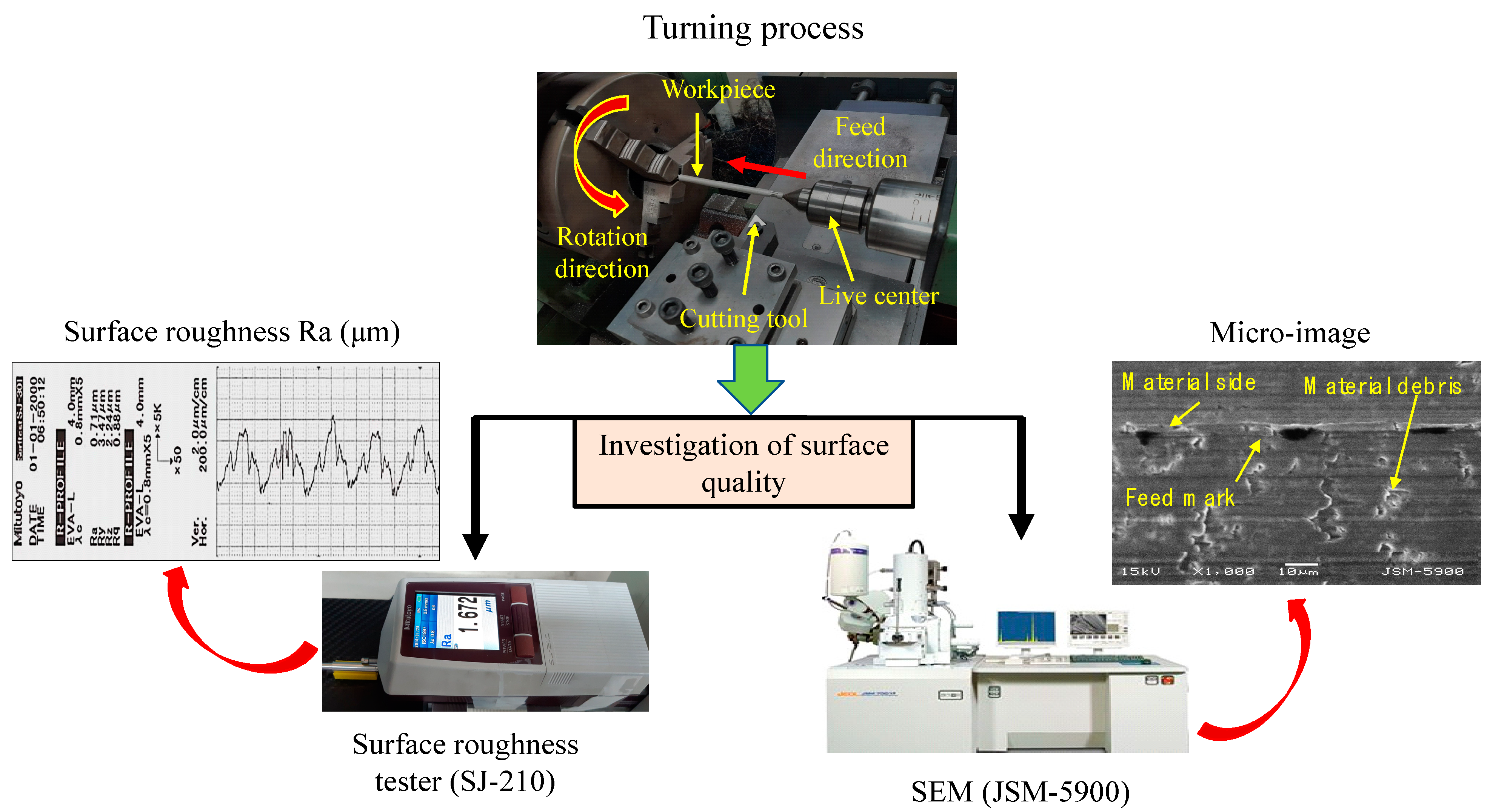
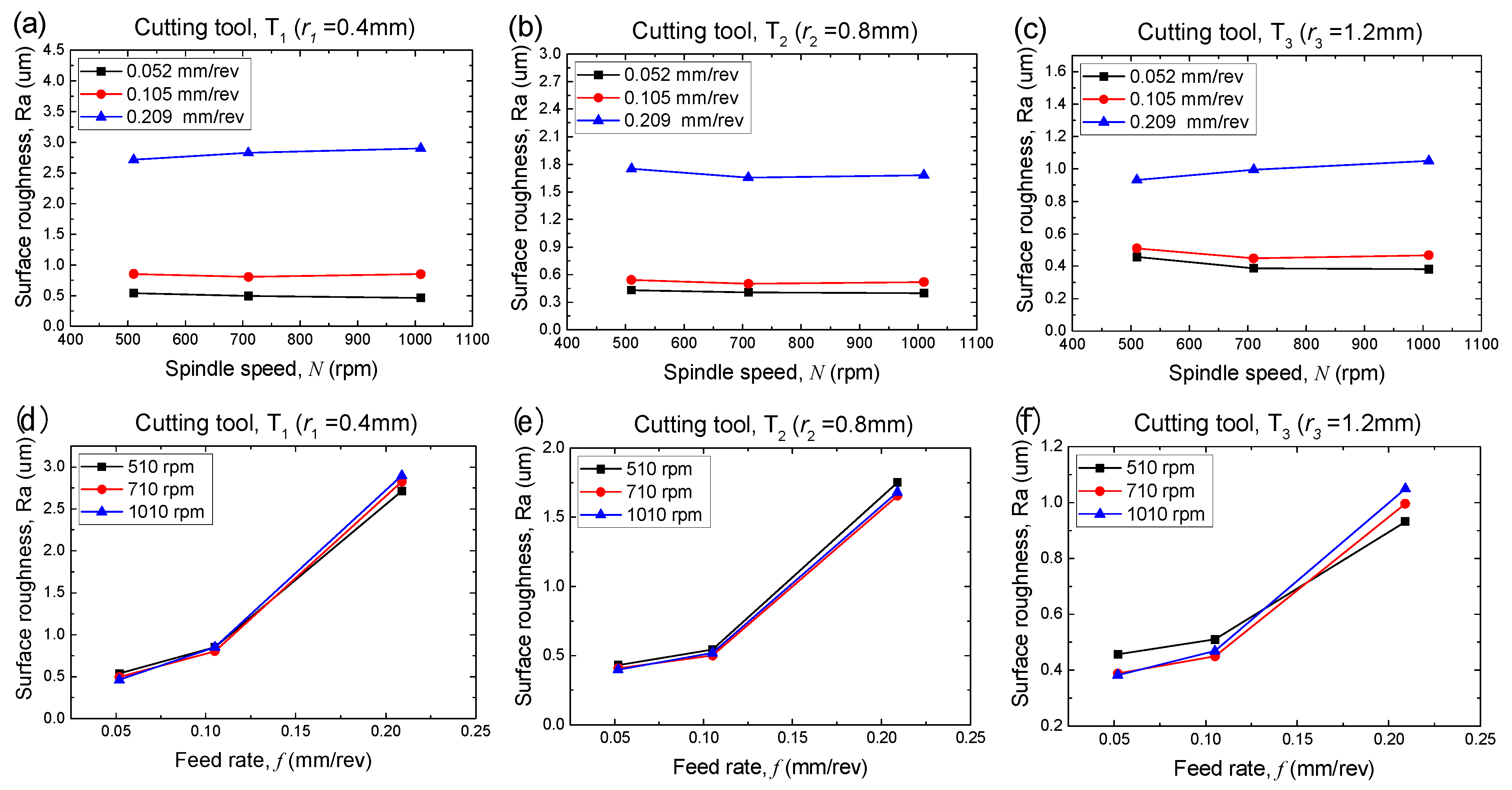

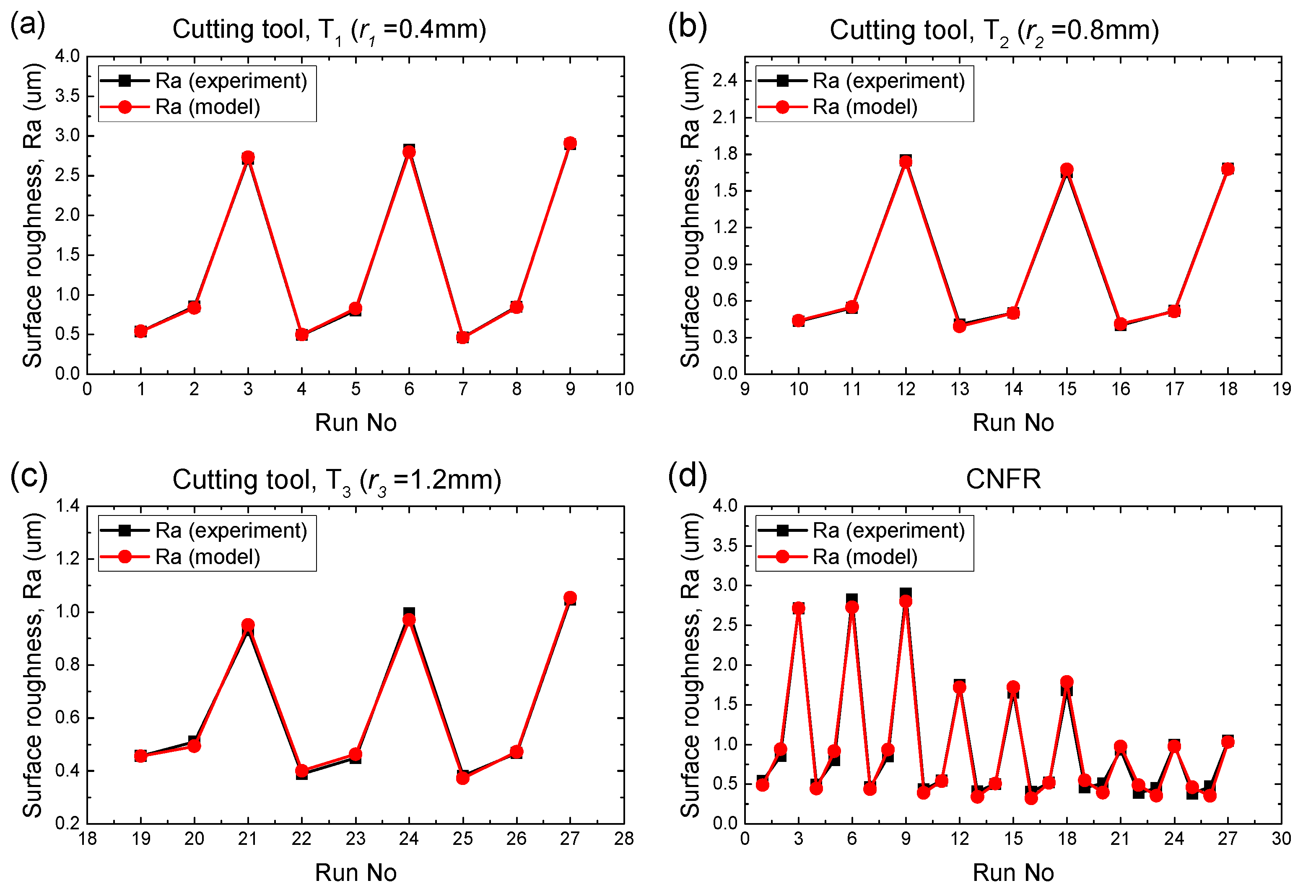
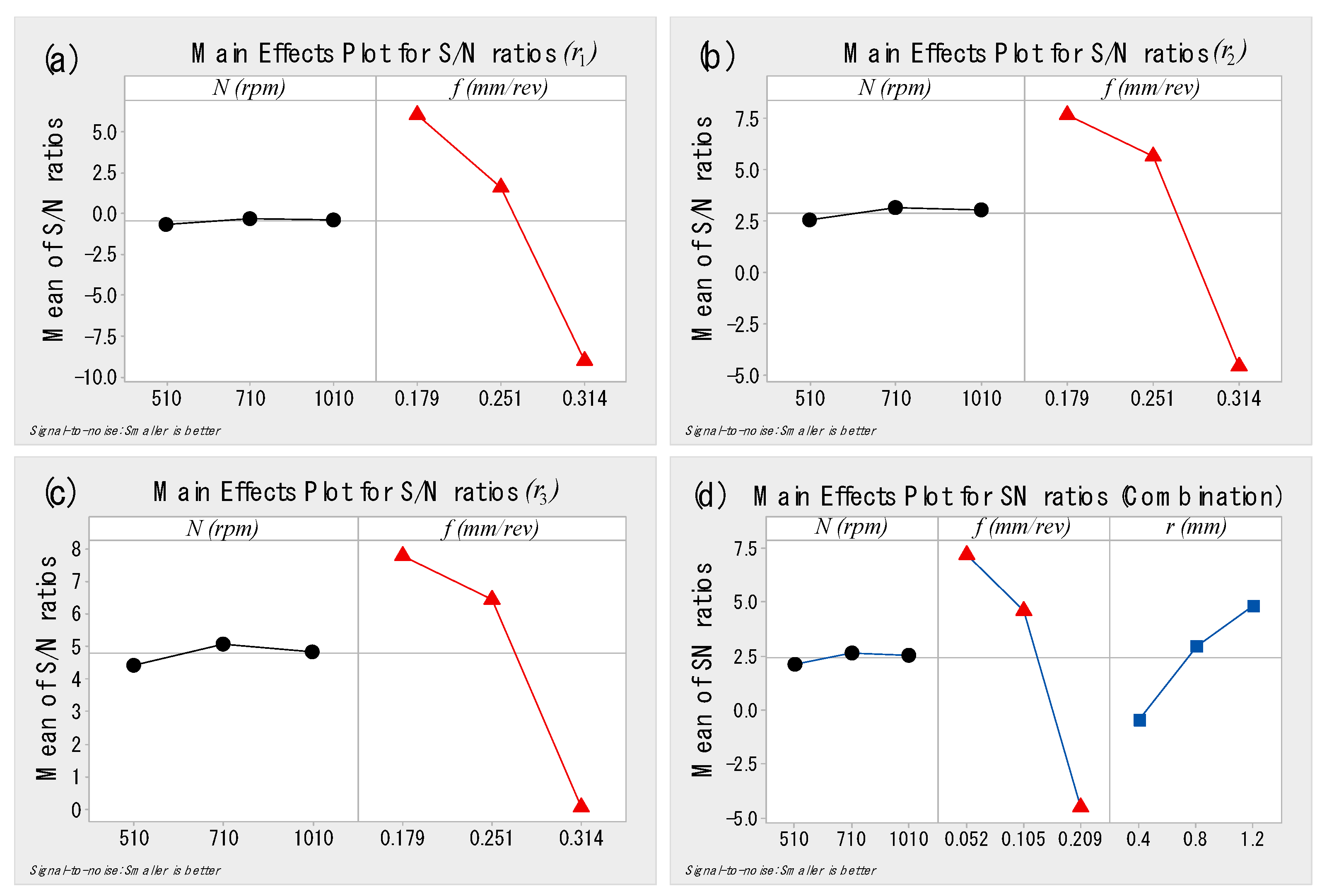
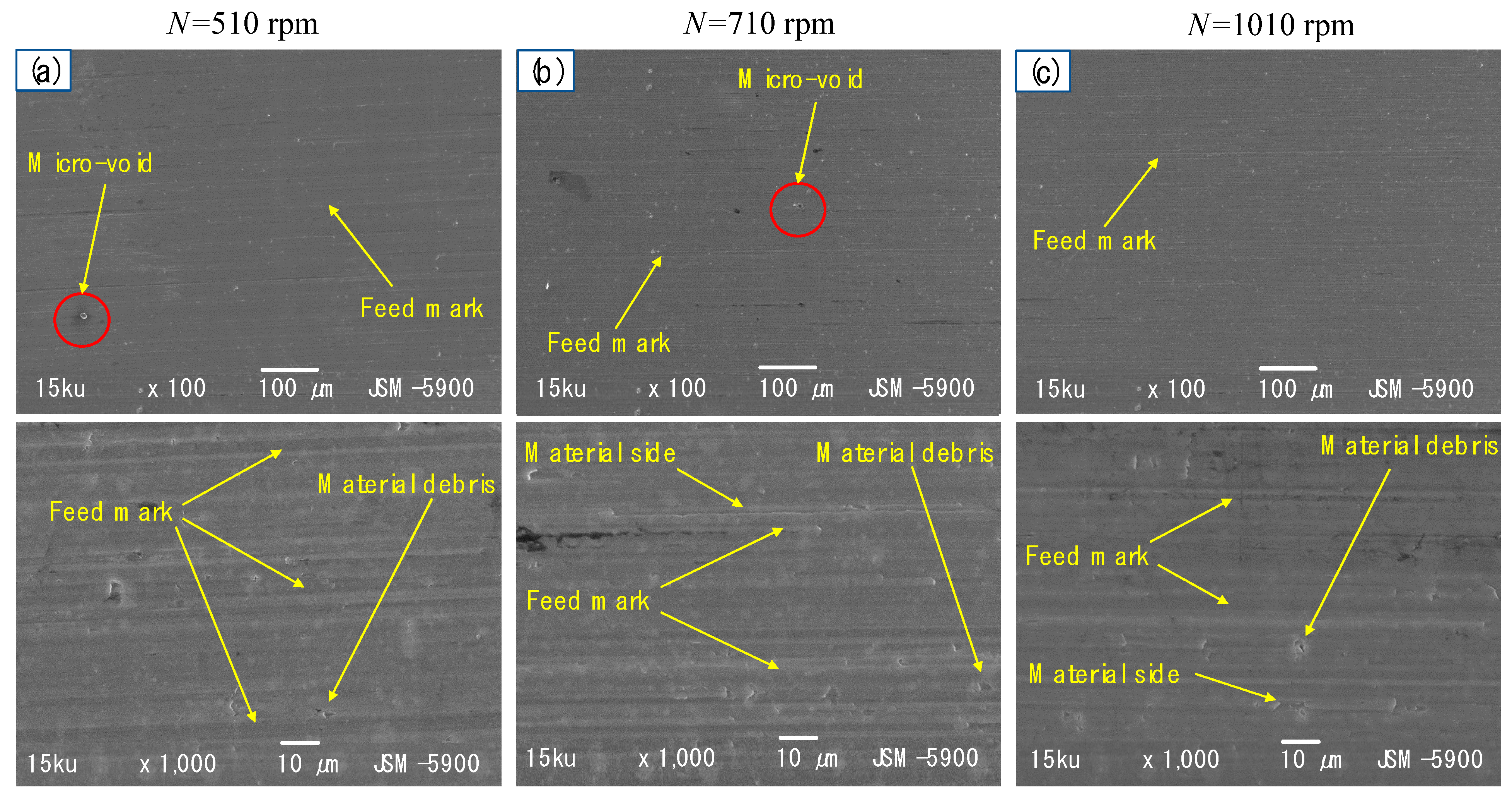
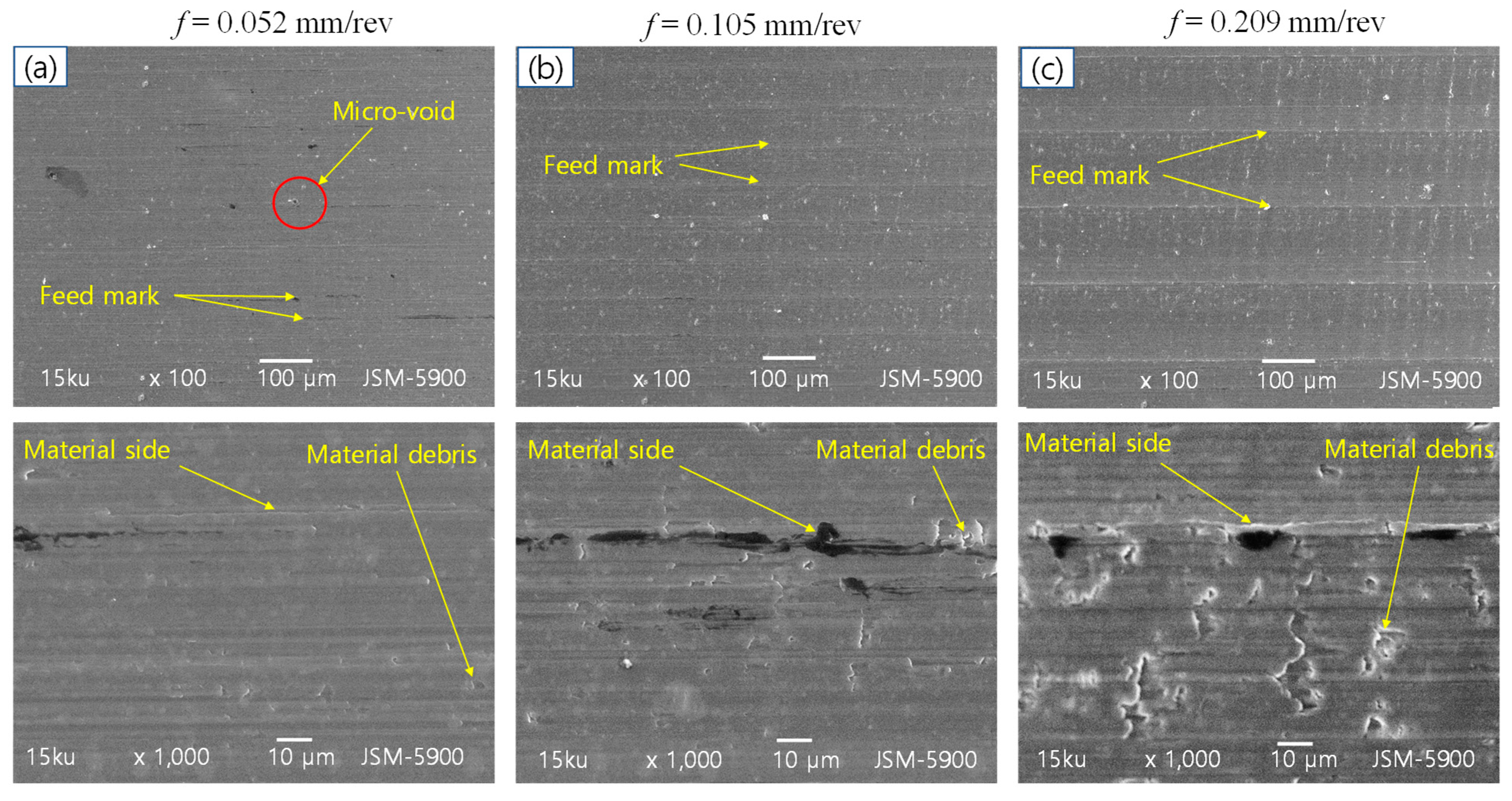

| Levels | Cutting Parameters | Environment | |||
|---|---|---|---|---|---|
| Tool Nose Radius r (mm) | Feed Rate f (mm/rev) | Spindle Speed N (rpm) | Depth of Cut d (mm) | ||
| 1 | 0.4 | 0.052 | 510 | 0.25 | Dry turning |
| 2 | 0.8 | 0.105 | 710 | ||
| 3 | 1.2 | 0.209 | 1010 | ||
| Cutting Tool | Run No. | Cutting Parameters | |||
|---|---|---|---|---|---|
| Spindle Speed N (rpm) | Feed Rate f (mm/rev) | Nose Radial r (mm) | |||
| T1 | 1 | 510 | 0.052 | r1 = 0.4 | 0.54 |
| 2 | 510 | 0.105 | 0.85 | ||
| 3 | 510 | 0.209 | 2.71 | ||
| 4 | 710 | 0.052. | 0.49 | ||
| 5 | 710 | 0.105 | 0.80 | ||
| 6 | 710 | 0.209 | 2.83 | ||
| 7 | 1010 | 0.052 | 0.46 | ||
| 8 | 1010 | 0.105 | 0.85 | ||
| 9 | 1010 | 0.209 | 2.90 | ||
| T2 | 10 | 510 | 0.052 | r2 = 0.8 | 0.43 |
| 11 | 510 | 0.105 | 0.54 | ||
| 12 | 510 | 0.209 | 1.75 | ||
| 13 | 710 | 0.052 | 0.41 | ||
| 14 | 710 | 0.105 | 0.50 | ||
| 15 | 710 | 0.209 | 1.66 | ||
| 16 | 1010 | 0.052 | 0.40 | ||
| 17 | 1010 | 0.105 | 0.52 | ||
| 18 | 1010 | 0.209 | 1.68 | ||
| T3 | 19 | 510 | 0.052 | r3 = 1.2 | 0.46 |
| 20 | 510 | 0.105 | 0.51 | ||
| 21 | 510 | 0.209 | 0.93 | ||
| 22 | 710 | 0.052 | 0.39 | ||
| 23 | 710 | 0.105 | 0.45 | ||
| 24 | 710 | 0.209 | 1.00 | ||
| 25 | 1010 | 0.052 | 0.38 | ||
| 26 | 1010 | 0.105 | 0.47 | ||
| 27 | 1010 | 0.209 | 1.05 | ||
| Tool Nose Radius | Source | DF | Adj SS | Adj MS | F-Value | p-Value | Remarks |
|---|---|---|---|---|---|---|---|
| r1 (0.4 mm) | N (rpm) | 2 | 0.00218 | 0.00109 | 0.22 | 0.812 | Insignificant |
| f (mm/rev) | 2 | 9.37852 | 4.68926 | 946.75 | 0.000 | Significant | |
| Error | 4 | 0.01981 | 0.00495 | - | - | - | |
| Total | 8 | 9.40051 | - | - | - | - | |
| r2 (0.8 mm) | N (rpm) | 2 | 0.00471 | 0.00236 | 6.22 | 0.059 | Insignificant |
| f (mm/rev) | 2 | 3.03588 | 1.51794 | 4009.63 | 0.000 | Significant | |
| Error | 4 | 0.00151 | 0.00038 | - | - | - | |
| Total | 8 | 3.04211 | - | - | - | - | |
| r3 (1.2 mm) | N (rpm) | 2 | 0.000935 | 0.000467 | 0.17 | 0.850 | Insignificant |
| f (mm/rev) | 2 | 0.609613 | 0.304806 | 110.62 | 0.000 | Significant | |
| Error | 4 | 0.011022 | 0.002755 | - | - | - | |
| Total | 8 | 0.621569 | - | - | - | - |
| Material | Source | DF | Adj SS | Adj MS | F-Value | p-Value | Remarks |
|---|---|---|---|---|---|---|---|
| Magnesium | N (rpm) | 2 | 0.003 | 0.00148 | 0.01 | 0.989 | Insignificant |
| f (mm/rev) | 2 | 10.3923 | 5.19616 | 38.94 | 0 | Significant | |
| r (mm) | 2 | 2.6759 | 1.33796 | 10.03 | 0.001 | Significant | |
| Error | 20 | 2.6689 | 0.13345 | - | - | - | |
| Total | 26 | 15.7401 | - | - | - | - |
| Tool Nose Radius (r) | Levels | Cutting Parameters | |
|---|---|---|---|
| Spindle Speed (N) | Feed Rate (f) | ||
| r1 | 1 | −0.6437 | 6.0553 |
| 2 | −0.3323 | 1.5649 | |
| 3 | −0.3839 | −8.9802 | |
| Delta | 0.3114 | 15.0355 | |
| Rank | 2 | 1 | |
| r2 | 1 | 2.575 | 7.674 |
| 2 | 3.133 | 5.660 | |
| 3 | 3.040 | −4.586 | |
| Delta | 0.558 | 12.260 | |
| Rank | 2 | 1 | |
| r3 | 1 | 4.42276 | 7.79418 |
| 2 | 5.06990 | 6.46410 | |
| 3 | 4.85002 | 0.08441 | |
| Delta | 0.64714 | 7.70977 | |
| Rank | 2 | 1 | |
| Levels | Cutting Parameters | ||
|---|---|---|---|
| Spindle Speed (N) | Feed Rate (f) | Tool Nose Radius (r) | |
| 1 | 2.1180 | 7.1745 | −0.4533 |
| 2 | 2.6236 | 4.5632 | 2.9161 |
| 3 | 2.5021 | −4.4940 | 4.7809 |
| Delta | 0.5055 | 11.6685 | 5.2342 |
| Rank | 3 | 1 | 2 |
Publisher’s Note: MDPI stays neutral with regard to jurisdictional claims in published maps and institutional affiliations. |
© 2021 by the authors. Licensee MDPI, Basel, Switzerland. This article is an open access article distributed under the terms and conditions of the Creative Commons Attribution (CC BY) license (https://creativecommons.org/licenses/by/4.0/).
Share and Cite
Hai, S.; Jung, H.-C.; Shim, W.-H.; Shin, H.-G. Investigation of Surface Quality for Minor Scale Diameter of Biodegradable Magnesium Alloys during the Turning Process Using a Different Tool Nose Radius. Metals 2021, 11, 1174. https://doi.org/10.3390/met11081174
Hai S, Jung H-C, Shim W-H, Shin H-G. Investigation of Surface Quality for Minor Scale Diameter of Biodegradable Magnesium Alloys during the Turning Process Using a Different Tool Nose Radius. Metals. 2021; 11(8):1174. https://doi.org/10.3390/met11081174
Chicago/Turabian StyleHai, Sophal, Hwa-Chul Jung, Won-Hyun Shim, and Hyung-Gon Shin. 2021. "Investigation of Surface Quality for Minor Scale Diameter of Biodegradable Magnesium Alloys during the Turning Process Using a Different Tool Nose Radius" Metals 11, no. 8: 1174. https://doi.org/10.3390/met11081174
APA StyleHai, S., Jung, H.-C., Shim, W.-H., & Shin, H.-G. (2021). Investigation of Surface Quality for Minor Scale Diameter of Biodegradable Magnesium Alloys during the Turning Process Using a Different Tool Nose Radius. Metals, 11(8), 1174. https://doi.org/10.3390/met11081174







